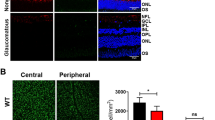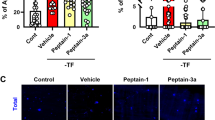Abstract
Optic neuropathy is associated with retinal ganglion cell (RGC) loss leading to optic nerve damage and visual impairment. Recent research has shown that transient block of connexin43 (Cx43) hemichannels by a Cx43 mimetic peptide (MP), Peptide5, delivered systemically or by intravitreal injection after retinal ischemia inhibits uncontrolled hemichannel opening to provide significantly reduced vessel leak and inflammation as well as significantly enhanced RGC survival. We have previously shown, in vitro, that a chemically modified C12-C12-Cx43 MP has a twofold greater half-life in bovine vitreous (ex vivo) than the native peptide. The present study investigated the ability of intravitreally injected, chemically modified C12-C12-Cx43 MP to further enhance RGC survival in a rat retinal ischemia-reperfusion model. Intravitreally injected native Cx43 MP or C12-C12-Cx43 MP both minimized vessel leak, reduced inflammation, and protected RGC after ischemic injury. However, the modified C12-C12-Cx43 MP, with its prolonged vitreous stability, showed significantly lower levels of Cx43 expression post-injury, with a trend towards a greater reduction in vessel leak and further RGC protection, suggesting that these molecules may be a clinically relevant neuroprotective tool in the treatment of optic neuropathy.






Similar content being viewed by others
References
Chen Y-S, Green CR, Danesh-Meyer HV, Rupenthal ID. Neuroprotection in the treatment of glaucoma—a focus on connexin43 gap junction channel blockers. Eur J Pharm Biopharm. 2015. doi:10.1016/j.ejpb.2015.01.031.
Hervé JC, Derangeon M. Gap-junction-mediated cell-to-cell communication. Cell Tissue Res. 2013;352(1):21–31.
Scemes E, Spray D, Meda P. Connexins, pannexins, innexins: novel roles of “hemi-channels”. Pflugers Arch-Eur J Physiol. 2009;457(6):1207–26.
Kar R, Batra N, Riquelme MA, Jiang JX. Biological role of connexin intercellular channels and hemichannels. Arch Biochem Biophys. 2012;524(1):2–15.
Chew SSL, Johnson CS, Green CR, Danesh-Meyer HV. Role of connexin43 in central nervous system injury. Exp Neurol. 2010;225(2):250–61.
Nagy JI, Rash JE. Connexins and gap junctions of astrocytes and oligodendrocytes in the CNS. Brain Res Rev. 2000;32(1):29–44.
Theis M, Giaume C. Connexin-based intercellular communication and astrocyte heterogeneity. Brain Res. 2012;1487:88–98.
Eugenin EA, Basilio D, Sáez JC, Orellana JA, Raine CS, Bukauskas F, et al. The role of gap junction channels during physiologic and pathologic conditions of the human central nervous system. J Neuroimmune Pharmacol. 2012;7(3):499–518.
Frantseva MV, Kokarovtseva L, Velazquez JLP. Ischemia-induced brain damage depends on specific gap-junctional coupling. J Cereb Blood Flow Metab. 2002;22(4):453–62.
Agullo-Pascual E, Lin X, Pfenniger A, Lübkemeier I, Willecke K, Rothenberg E, et al. A novel noncanonical role of Cx43 in the heart: ensuring the arrival of Nav1.5 to the intercalated disk. Heart Rhythm. 2013;10(11):1742.
Goodenough DA, Paul DL. Beyond the gap: functions of unpaired connexon channels. Nat Rev Mol Cell Biol. 2003;4(4):285–95.
Contreras JE, Sáez JC, Bukauskas FF, Bennett MV. Gating and regulation of connexin 43 (Cx43) hemichannels. Proc Natl Acad Sci. 2003;100(20):11388–93.
O’Carroll SJ, Gorrie CA, Velamoor S, Green CR, Nicholson LF. Connexin43 mimetic peptide is neuroprotective and improves function following spinal cord injury. Neurosci Res. 2013;75(3):256–67.
Davidson JO, Green CR, Nicholson B, Louise F, O’Carroll SJ, Fraser M, et al. Connexin hemichannel blockade improves outcomes in a model of fetal ischemia. Ann Neurol. 2012;71(1):121–32.
Davidson JO, Green CR, Bennet L, Nicholson LF, Danesh-Meyer H, O’Carroll SJ, et al. A key role for connexin hemichannels in spreading ischemic brain injury. Curr Drug Targets. 2013;14(1):36–46.
Danesh-Meyer HV, Kerr NM, Zhang J, Eady EK, O’Carroll SJ, Nicholson LFB, et al. Connexin43 mimetic peptide reduces vascular leak and retinal ganglion cell death following retinal ischaemia. Brain. 2012;135(2):506–20.
Gomes P, Srinivas SP, Van Driessche W, Vereecke J, Himpens B. ATP release through connexin hemichannels in corneal endothelial cells. Invest Ophthalmol Vis Sci. 2005;46(4):1208–18.
De Vuyst E, Decrock E, De Bock M, Yamasaki H, Naus CC, Evans WH, et al. Connexin hemichannels and gap junction channels are differentially influenced by lipopolysaccharide and basic fibroblast growth factor. Mol Biol Cell. 2007;18(1):34–46.
Contreras JE, Sánchez HA, Eugenín EA, Speidel D, Theis M, Willecke K, et al. Metabolic inhibition induces opening of unapposed connexin 43 gap junction hemichannels and reduces gap junctional communication in cortical astrocytes in culture. Proc Natl Acad Sci. 2002;99(1):495–500.
Davidson JO, Drury PP, Green CR, Nicholson LF, Bennet L, Gunn AJ. Connexin hemichannel blockade is neuroprotective after asphyxia in preterm fetal sheep. PLoS ONE. 2014;9(5), e96558.
Retamal MA, Froger N, Palacios-Prado N, Ezan P, Saez PJ, Saez JC, et al. Cx43 hemichannels and gap junction channels in astrocytes are regulated oppositely by proinflammatory cytokines released from activated microglia. J Neurosci. 2007;27(50):13781–92.
Ramachandran S, Xie L-H, John SA, Subramaniam S, Lal R. A novel role for connexin hemichannel in oxidative stress and smoking-induced cell injury. PLoS ONE. 2007;2(8), e712.
De Bock M, Culot M, Wang N, Bol M, Decrock E, De Vuyst E, et al. Connexin channels provide a target to manipulate brain endothelial calcium dynamics and blood–brain barrier permeability. J Cereb Blood Flow Metab. 2011;31(9):1942–57.
Cronin M, Anderson PN, Cook JE, Green CR, Becker DL. Blocking connexin43 expression reduces inflammation and improves functional recovery after spinal cord injury. Mol Cell Neurosci. 2008;39(2):152–60.
Bergeon JA, Toth I. Enhancement of oral drug absorption—effect of lipid conjugation on the enzymatic stability and intestinal permeability of l-Glu-l-Trp-NH2. Bioorg Med Chem. 2007;15(22):7048–57.
Blanchfield J, Toth I. Lipid, sugar and liposaccharide based delivery systems 2. Curr Med Chem. 2004;11:2375–82.
Tóth I, Malkinson JP, Flinn NS, Drouillat B, Horváth A, Érchegyi J, et al. Novel lipoamino acid- and liposaccharide-based system for peptide delivery: application for oral administration of tumor-selective somatostatin analogues. J Med Chem. 1999;42(19):4010–3.
Chen Y-S, Toth I, Danesh-Meyer HV, Green CR, Rupenthal ID. Cytotoxicity and vitreous stability of chemically modified connexin43 mimetic peptides for the treatment of optic neuropathy. J Pharm Sci. 2013;102(7):2322–31.
Buchi ER, Suivaizdis I, Fu J. Pressure-induced retinal ischemia in rats: an experimental model for quantitative study. Ophthalmologica. 1991;203(3):138–47.
Sun D, Vingrys AJ, Kalloniatis M. Metabolic and functional profiling of the ischemic/reperfused rat retina. J Comp Neurol. 2007;505(1):114–30.
Cervia D, Casini G. Recent advances in cellular and molecular aspects of mammalian retinal ischemia. World J Pharmacol. 2012;1:30–43.
Ylitalo KV, Ala-Rämi A, Liimatta EV, Peuhkurinen KJ, Hassinen IE. Intracellular free calcium and mitochondrial membrane potential in ischemia/reperfusion and preconditioning. J Mol Cell Cardiol. 2000;32(7):1223–38.
Frantseva MV, Kokarovtseva L, Naus CG, Carlen PL, MacFabe D, Velazquez JLP. Specific gap junctions enhance the neuronal vulnerability to brain traumatic injury. J Neurosci. 2002;22(3):644–53.
Chen Y-S, Green CR, Wang K, Danesh-Meyer HV, Rupenthal ID. Sustained intravitreal delivery of connexin43 mimetic peptide by poly(d, l-lactide-co-glycolide) acid micro- and nanoparticles—closing the gap in retinal ischaemia. Eur J Pharm Biopharm. 2014. doi:10.1016/j.ejpb.2014.12.005.
Kerr NM, Johnson CS, de Souza CF, Chee KS, Good WR, Green CR, et al. Immunolocalization of gap junction protein connexin43 (GJA1) in the human retina and optic nerve. Invest Ophthalmol Vis Sci. 2010;51(8):4028–34.
Kim JH, Kim JH, Park JA, Lee S, Kim WJ, Yu YS, et al. Blood-neural barrier: intercellular communication at glio-vascular interface. J Biochem Mol Biol. 2006;39(4):339.
Simard M, Arcuino G, Takano T, Liu QS, Nedergaard M. Signaling at the gliovascular interface. J Neurosci. 2003;23(27):9254–62.
Venkatesha RT, Ahamed J, Nuesch C, Zaidi AK, Ali H. Platelet-activating factor-induced chemokine gene expression requires NF-κB activation and Ca2+/calcineurin signaling pathways. Inhibition by receptor phosphorylation and beta-arrestin recruitment. J Biol Chem. 2004;279(43):44606–12.
Krueger M, Härtig W, Reichenbach A, Bechmann I, Michalski D. Blood–brain barrier breakdown after embolic stroke in rats occurs without ultrastructural evidence for disrupting tight junctions. PLoS ONE. 2013;8(2), e56419.
Halfter W, Dong S, Dong A, Eller AW, Nischt R. Origin and turnover of ECM proteins from the inner limiting membrane and vitreous body. Eye. 2008;22(10):1207–13.
Acknowledgments
The authors would like to thank Professor Toth’s group for their support during the synthesis and modification of the Cx43 MP. We acknowledge the Auckland Medical Research Foundation (1210003) for the financial support in the form of a doctoral scholarship for Ying-Shan Chen and the Buchanan Charitable Foundation and the Health Research Council of New Zealand (13/692 and 14/018) for their financial support.
Conflict of interest
Professor Colin Green is a founding scientist of CoDa Therapeutics, Inc. USA, which holds intellectual property for the use of connexin peptides to regulate gap junction channels for the treatment of ocular disease.
Author information
Authors and Affiliations
Corresponding author
Rights and permissions
About this article
Cite this article
Chen, YS., Green, C.R., Teague, R. et al. Intravitreal injection of lipoamino acid-modified connexin43 mimetic peptide enhances neuroprotection after retinal ischemia. Drug Deliv. and Transl. Res. 5, 480–488 (2015). https://doi.org/10.1007/s13346-015-0249-8
Published:
Issue Date:
DOI: https://doi.org/10.1007/s13346-015-0249-8




